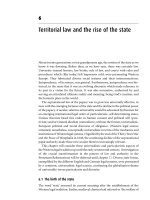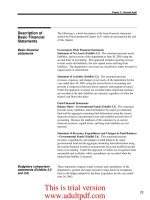Diversity and seasonal availability of potential wild edible plants from Vidarbha region of Maharashtra state, India
Bạn đang xem bản rút gọn của tài liệu. Xem và tải ngay bản đầy đủ của tài liệu tại đây (663.22 KB, 13 trang )
Int.J.Curr.Microbiol.App.Sci (2019) 8(2): 1434-1446
International Journal of Current Microbiology and Applied Sciences
ISSN: 2319-7706 Volume 8 Number 02 (2019)
Journal homepage:
Original Research Article
/>
Diversity and Seasonal Availability of Potential Wild Edible Plants from
Vidarbha Region of Maharashtra State, India
K.C. Kiran1*, C. Dhanush1, C.V Gajendra2 and B.M. Reddy3
1
Department of forestry and environmental science, UAS, Bengaluru, Karnataka, India
2
Forest collage and research institute, Mettupalayam, TNAU, Tamil Nadu, India
3
Forest research institute, Dehradun, Uttarkhand, India
*Corresponding author
ABSTRACT
Keywords
Wild edible plants,
Diversity, Food
security, Vidarbha
region
Article Info
Accepted:
12 January 2019
Available Online:
10 February 2019
Wild edible plants (WEPs) are the species that are neither cultivated nor domesticated, but
available from their natural habitat and used as a source of food. Use of wild edibles is
diminishing at fast pace but it is clear that in many parts of the world the use of wild
edibles is still prevalent. Consumption of wild edibles is a major source of vitamins and
micro-nutrients for people using only vegetarian diets rich in carbohydrates. The present
study deals with the study of diversity and seasonal availability of WEPs and documented
147 species of wild edible plants belonging to 66 families and it reveals information about
various edible parts of different species which includes corms, tubers, leaves, flowers,
fruits and seeds, which are consumed by tribes and local people. All these plants are
common in rural and forest area of Vidarbha region of Maharashtra. Majority of thespecies
belongs to the families are Caesalpiniaceae, Fabaceae, Amaranthaceae, Araceae,
Rubiaceae, Convolvulaceae, Cucurbitaceae, Dioscoreaceae, Tiliaceae, Anacardiaceae,
Bignoniaceae, Combertaceae, Euphorbiaceae, Malvaceae, Moraceae. Collection and
utilization of wild edible plants provide seasonal food security and become source of
income to the tribes and local people.
Introduction
Wild edible plants (WEPs) refer to species
that are neither cultivated nor domesticated,
but available from their natural habitat and
used as sources of food (Beluhan and
Ranogajec, 2010). Wild edible plants have
since ancient times, played a very important
role in human life; they have been used for
food, medicines, fibre and other purposes and
also as fodder for domestic animals (Kanchan,
2011). Various studies have found wild edible
plants are the potential source of nutrition
while in many cases is more nutritious than
the conventionally eaten crops (Grivetti and
Ogle, 2000). India is the second largest
human populations in this planet, 68.8% of
the population is living in the rural areas
(Census, 2011). Most rural communities
depend on the resources which are available
in nature, including wild edible plants to meet
their food needs in periods of food crises, in
addition to added food supplements (Rashid,
2008).
1434
Int.J.Curr.Microbiol.App.Sci (2019) 8(2): 1434-1446
Food insecurity, on the other hand, is a
situation of "limited or uncertain availability
of nutritionally adequate and safe foods or
limited or uncertain ability to acquire
acceptable foods in socially acceptable ways",
according to the United States Department of
Agriculture (USDA). Attaining food security
is a matter of prime importance for India
where more than one third of its population is
estimated to be absolutely poor, and as many
as one half of its children have suffered from
malnourishment over the last three decades
(Ittyerah, 2013).
WEPs are gathered for food, nutrition and
livelihoods by different cultures around the
world. These plants are gathered from varied
habitats from natural forests, agricultural
fields to human disturbed areas such as
roadsides and wastelands. Forest forms the
most important source of wild foods for rural
households and forest inhabitants. Among
some indigenous people utilization of WEPs
is integral component of their culture. Various
studies have found wild edible plants are
potential source of nutrition while in many
cases are more nutritious than conventionally
eaten crops (Grivetti and Ogle, 2000). Besides
food and nutrition, utilization of WEPs as
coping strategies during scarcity is prevalent,
particularly in developing countries where
food insecurity is more acute. Diversity of
plant foods consumed provides nutritional
diversity and also food during famine or
scarcity of favoured foods (Hatloy et al.,
1998). Potential of WEPs in providing source
of income and livelihoods in rural settings is
acknowledged around the world (Dutta,
2012).
Traditional knowledge exists worldwide in all
communities covering varied areas including
health, agriculture and natural resource
management. In case of the developing world
Africa and Latin America are also rich in
traditional knowledge but they are to be found
by and large only as oral traditions. Asia in
general and India in particular have a
distinction that traditional knowledge is found
not just as oral tradition but also as classical
literature that is written down with its own
theoretical framework and with a clear
exposition of the basic principles of world
views (Nene, 2012). There are reports on wild
food plants used during famine in Indian
conditions (Nene, 2004; Balkundi, 1998). In
some areas local food produce is hardly
sufficient to meet about two thirds of local
requirements. Thus for about four months in
each year some of its unfortunate inhabitants
have to migrate to the neighbouring cities and
remaining people are obliged to subsist on a
starvation diet.
These people use many plants, occurring
naturally in neighbouring forests, as
supplementary food which alone enables them
to carry on with their half-starved existence.
For that we should document the existing wild
edible, which in turn helps in other people
could get to know about the edible plants
around them. Earlier work on wild edible
plants from many parts of Maharashtra like
Nasik, Amravati, Buldhana, Kolhapur,
Chandrapur, Jalgaon, Akola and Nagpurwere
carried out by Patil and Patil, (2000),
Bhogaonkar et al., (2010), Kshirsagar et al.,
(2012), Mahadkar and Jadhav (2013), Joshi et
al.,(2013), Reddy, (2012), Patil and Patil,
(2012), Jadhav et al., (2011), Patil and Tale,
(2018), Thakre and Srinivasu (2012) and
Kamble et al., (2013).
Materials and Methods
The present study was conducted in Vidarbha
region of Maharashtra, to identify and
document the wild edible plants and their
habit, habitat, local availability, season of
availability etc. for the period of 2015-16. A
gist of Vidarbha region is given below to
know about the region.
1435
Int.J.Curr.Microbiol.App.Sci (2019) 8(2): 1434-1446
Study region
Vidarbha is the eastern region of the Indian
state of Maharashtra, comprising Nagpur
Division and Amravati Division (Plate 1). It
occupies 31.6% of the total area and holds
21.3% of the total population of Maharashtra.
Vidarbha is located right at the heart of the
Indian Union occupying 97,426 sq. km. area
between 19⁰ 05’ to 21⁰ 47’ North latitude and
75⁰ 59' to 79⁰ 11' East longitude. Vidarbha
shares its boundary with the state of Madhya
Pradesh towards the north, Chattisgarh in the
east, Andhra Pradesh in the south and Nasik
and Aurangabad administrative division of
Maharashtra state in the west. Geographically,
Vidarbha lies in the fertile plateau between
Melghat in the Satpura range in the north and
Balaghat in the Ajantha Range in the south.
This area is also known as Payanghat. Rich
with bounties of nature Vidarbha consists of
the Amravati and Nagpur administrative
division of Maharashtra. Amravti division
comprises of five districts – Buldhanana,
Akola, Washim, Yamatwal besides Amravati
district. The Nagpur division comprises of six
districts – Wardha, Bhandara, Gondia,
Chandrapur, Gardchiroli besides Nagpur
district. In all, Vidarbha represents eleven
districts. It is the rich biodiversity and varying
geographical conditions have been ideal for
growth of variety of plants of Vidarbha.
Broadly the vegetation can be divided into
evergreen forests, deciduous forests and
thorny scrub forests, makes it all season
availability of wild edible plant resources in
this region.
Field survey conducted for documentation
of WEPs
Field survey was conducted through
interview, using questionnaire and focal
group discussions were made involving
traditional medicine practitioner, forest
department people and old knowledgeable
persons. Interactions with the tribal people
about the collection and uses of WEPs from
the forest. Special efforts were made to
involve women in the exercise, self-help
groups (SHG) of women help a lot to
document the WEPs. Identification of WEPs
is by their local name and availability of
different wild edible plants and collection of
different parts in different months of the year.
All the available information was recorded
and a documentation of WEPs was done in
required format and analysed using ExcelStat.
Results and Discussion
WEP resource of Vidarbha region
The present study documented 147 species of
wild edible plants belonging to 66 families.
As other studies like, Reddy et al., (2012)
documented 61 species of WEPs in
Chandrapur district, Deshpande et al., (2015)
recorded 73 WEPs belonging to 42 families
which are used by Rajgond tribes of Vidarbha
region, Patil and Patil (2012) mentioned in his
work that there are 43 endangered WEPs are
there in Jalgaon district, Bhogaonkaret al.,
(2010) documented 42 WEPs belonging to 23
families in Melghat forest area of Amravti
district and Patil and Tale (2018) documented
20 WEPs used by local people in Akola
district.
The detailed analysis of their taxonomic
group revealed 147 species, belong to 66
families (Table 1). With respect to families,
Caesalpiniaceae shared the largest proportion
by consisting of 10 species and followed by
Amaranthaceae and Fabaceae with 8 species,
Araceae and Rubiaceae with 6 species,
Cucurbitaceae and Tiliaceae with 5 species,
Anacardiaceae,
Combretaceae,
Convolvulaceae, Malvaceae, Mimosaceae and
Rhamnaceae 4 species each, Dioscoreaceae
and Euphorbiaceae with 3 species, these are
1436
Int.J.Curr.Microbiol.App.Sci (2019) 8(2): 1434-1446
the top fifteen families having highest number
of WEP species.
WEPs are available in different life forms. In
the present study shows that the largest
proportion of wild edible species were in the
form of tree i.e.48 species (32.7%), followed
by herbs 44 species (29.9%), shrubs 28
species (19%), climbers 23 species (15.6%),
palm 2 species (1.4%), Aquatic plant and
grass one species each (0.7%) respectively
which is illustrated in the figure 1. The major
consumed wild edible plant part is fruits24%
and leaves 23%, then followed by whole plant
and flowers with 10% each, seeds 8%, pods
7%, tuber 5%, root 4%, shoot 3%, gum and
bulbs with 2% each, bark 1.4%, stem 0.68%,
which is illustrated in the figure 2. The tribes
and local village people consume wild tubers,
rhizomes and corms either in raw or baked or
boiled or roasted form. Some of the edible
parts like, leaves and fruits are also eaten raw,
other parts like, tender shoots, flowers, leaves,
pods, fruits, etc. and whole plant which are
used as vegetable and as well as medicinal
purposes. Efforts were also made to explore
the nutritive potential of some wild edible
tubers, rhizomes, leafy vegetables and wild
fruits which supplement several nutrients
particularly calcium and carotenoids. Such
unconventional wild edible plants are sources
of fats, proteins, rich source of micronutrients and trace elements (Nilegaonkar et
al., 1985; Kulkarni et al., 2003; Kulkarni,
2006).
Seasonal availability and Occurrence of
WEPs in different localities
In the Vidarbha region, the availability of
WEPs is seen all over the year (Figure 3). The
peak season of available of WEPs is in the
rainy season (June to October) in the different
habitats. Majority of the WEPs are
herbaceous and short duration climbers are
available for human consumption. The reason
for the availability of WEPs throughout the
year is, one or the other species of wild edible
plants show their presence in different
seasons and producing different edible parts
from them, for example, Annona squamosa
produces fruit from December to May,
Mangifera indica produces fruit from March
to June, Syzygium cumunii produces fruit
from June to August, Terminalia catappa
produces fruit from August to October,
Limonia acidissima produces fruit from
November to December, likewise one or other
edible parts are available throughout the year.
Besides providing good source of nutrients
available in different seasons of the year,
these species also provide ecological security
as they are disease resistant, grow in diverse
climates and habitat and ensure sufficient
production even in adverse conditions. The
production potential of different species and
sustainable harvest of useful parts can boost
the local economy. Similar type of study was
done by Deshpande et al., (2015).
The occurrence of WEPs in Vidarbha region
was classified into 11 different localities. The
representation of species were maximum in
forest area (70 %), followed by waste land (21
%), village (15 %), road side and kitchen
garden 14% each, field boundaries (12 %),
water body (10 %), marshy area and pond
boundaries 5 % each, agriculture field and
densely forest area 3% each, which is
illustrated in the figure 4. Forest is the home
for the majority of WEPs. In the Vidarbha
region waste lands and road side places are
also contributing for food source by the
presence of edible plants species there. Most
of the villagers and tribal people, in their
kitchen garden they grow vegetables, tubers,
beans and chillies, etc. (Kulkarni and
Kumbhojkar, 1993).
1437
Int.J.Curr.Microbiol.App.Sci (2019) 8(2): 1434-1446
Table.1 Potential WEPs diversity documented in Vidarbha region
Sl.
No.
1
Species
Family
Local name
Habit
Habitat
Season
Edible
parts
WP
Malvaceae
Kasturi
Herb
2
Sept – Mar
Malvaceae
Ran bhendi
Herb
2, 6
Sept – Feb
3
4
Abelmoschus ficulneus (L.)
Wight &Arn.
Abelmoschus manihot (L.)
Medik
Abrus precatorius L.
Acacia concinna (Willd.) DC.
Fabaceae
Mimosaceae
Gunj
Shikakai
Climber
Climber
11
1, 3, 2
Oct – May
Sept – Dec
5
Acacia nilotica (L.) Willd.
Mimosaceae
Baval, Babool
Tree
TOY
6
Acacia Senegal (L.) Willd.
Mimosaceae
Tree
TOY
7
8
9
Rutaceae
Agavaceae
Alanginaceae
Tree
Shrub
Tree
11
2,4, 1
6
Mar – June
TOY
Mar – Oct
Fr.
Fl.
Fr.
Araceae
Dhopa
Herb
7, 3
TOY
L, Rh.
11
Aegle marmelos L. Correa
Agave vera-cruz Mill.
Alangium salviifolium (L.f.)
Wangerin
Alocasia macrorhiza (L.)
G.Don.
Amaranthus cruentus L.
Goradiyo,
Baval
Bel
Ghaypat
Ankol
1, 4, 9, 3,
2
1, 4, 2, 3
B, R,
Fl., L
L, Fl.
Sh., P,
L
B, P,
G, S, L
L, G, P
Amaranthaceae
Herb
5
June – Oct
WP
12
13
Amaranthus paniculatus L.
Amaranthus tricolour L.
Amaranthaceae
Amaranthaceae
Herb
Herb
5, 1
5
TOY
June – Feb
WP
WP
14
15
16
Amarantus spinosus L.
Amarantus viridis L.
Amarphophallus
paeonifollius(Densst)
Nicolson
Ammannia baccifera Linn.
Amorphophallus
campanulatus(Roxb.) Blume
Amorphophallus
konkanensisHett.
Andrographis
paniculataWall.
Anethum graveolensL.
Annona reticulataL.
Annona squamosaL.
Anogeissus latifolia (DC.)
Wallich
Aristolochia indica L.
Asparagus racemosusWilld.
Atriplex hortensis L.
Amaranthaceae
Amaranthaceae
Araceae
Rajgira,
Tandulga
Rajgira
Taduljira, Lal
mat
Kale-math
Tanduliya
Gavathisuran
Herb
Herb
Shrub
2, 1
5, 1
1, 5
TOY
TOY
June – Oct
L, R
WP
T
Lythraceae
Araceae
Aginbuti
Suran
Herb
Shrub
7, 8
1, 5
June – Oct
June – Oct
L
Rh.
Araceae
Bhasmakanda
Herb
1
June – Oct
L, T
Acanthaceae
Kadukirayata
Herb
11
June – Feb
WP
Apiaceae
Annonaceae
Annonaceae
Combertaceae
Shepu
Sitafal
Sitafal
Dhawda
Herb
Tree
Tree
Tree
5
4, 3
1, 4, 3
1
TOY
Dec – May
Dec – May
Apr – Dec
WP
Fr.
Fr.
G
Aristolocaceae
Asparagaceae
Amaranthaceae
Ishwari
Shatavari
Chandanbatva
Climber
Herb
Shrub
1
2, 1
1
June – Feb
June – Jan
TOY
Fl.
WP
WP
2
10
17
18
19
20
21
22
23
24
25
26
27
1438
Int.J.Curr.Microbiol.App.Sci (2019) 8(2): 1434-1446
28
29
30
31
Azadiracta indicaA. Juss.
Basella rubraLinn.
Bauhinia perpureaL.
Bauhinia racemosaL.
Meliaceae
Basellaceae
Caesalpiniaceae
Caesalpiniaceae
Nimboni
Bacchalikoora
Kanchan
Apta
Tree
Climber
Tree
Tree
1, 4, 3
5
1, 5
1, 6
Mar – May
TOY
Jan – Mar
Mar – July
32
33
Bauhinia vahlii Wight &Arn.
Bauhinia variegate L.
Caesalpiniaceae
Caesalpiniaceae
Tree
Tree
1
1, 6, 2
Apr – Oct
Nov – Mar
34
Begonia crenataDryand.
Begoniaceae
Herb
9, 7
Aug – Nov
35
36
37
38
Boerhavia diffusa L.
Bombax ceiba L.
Borassus falbellifer Linn.
Boswellia serrata Roxb.
Nyctaginaceae
Bombacaceae
Arecaceae
Burseraceae
Chamul
Kanchan,
Kanaraj
Kapru,
Khadakambadi
Ghetuli
Katesavar
Tadi
Dhupali, Salai
Herb
Tree
Palm
Tree
4, 1, 2
1, 3
1, 4, 6, 2
1
Aug – Dec
Feb – Apr
Nov – May
Feb – Jun
39
Brassica compestris Linn.
Crucifereae
Herb
3
Nov – Apr
WP
L, Fl.
Fr.
Fr., Fl.,
S
P
40
41
42
Euphorbiaceae
Anacardiaceae
Fabaceae
Tree
Tree
Climber
1, 11
1
1, 5
TOY
Apr – May
Apr – Oct
R
Fr., S
Fr.
Shrub
1
Mar – Oct
Fr.
44
45
Bridelia retusa (L.) A.Juss.
Buchanania lanzan Spreng.
Cannavalia gladiate (Jacq.)
DC.
Canthium coromandelicum
(N.Burm.) Alst.
Canthium parviflorum Lamk
Capparis zeylanica L.
Shrub
Climber
1, 4
1
Apr – Aug
Mar – May
Fr. L
Fr.
46
47
48
49
Cassia fistula L.
Cassia mimoesides L.
Cassia occidentalis Linn.
Cassia tora L.
Caesalpiniaceae
Caesalpiniaceae
Caesalpiniaceae
Caesalpiniaceae
Katbor
Vaghati,
Orkali
Bahava
Lajari
Marha, Bacca
Takala, Tarota
Tree
Herb
Shrub
Shrub
1, 6, 4
1
1
2, 3, 1
May – Jun
Aug – Dec
Aug – Dec
Aug – Dec
50
51
52
53
Celosia argentia L.
Ceropegia bulbosa Roxb
Chenopodium album L.
Chlorophytum
tuberosum(Roxb.) Baker
Citrullus colocynthis(L.)
Schrad.
Clerodendrum seratumL.
Moon
Coccinia grandis(L.) Voigt.
Colocasia esculentaL.
Commelina benghalensisL.
Corchorus capsularisL
Amaranthaceae
Asclepiadaceae
Chenopodiaceae
Liliaceae
Herb
Climber
Herb
Herb
8
1
1, 2
1
June – Feb
June – Feb
TOY
Jun – Sept
Climber
7, 2
May – Oct
WP
Verbenaceae
Kurdu
Suparikanda
Chakvath
Shevalikardi,
Longdabhaji
Kaduindravani
Bharangi
Fl., P
P
WP
Sh., L,
Fl., P,
S
L
T
Sh., L
T, L
Shrub
1, 4, 6
Oct –May
L, Fl.
Cucurbitaceae
Araceae
Commelinaceae
Tiliaceae
Tondali
Kochai
Kena
Chunch
Climber
Herb
Herb
Herb
3, 1
5, 8, 7, 9
4, 7
3
Dec – Apr
Sept – Nov
June – Oct
Mar – May
Fr.
L, T
L
L
43
54
55
56
57
58
59
Rubiaceae
Rubiaceae
Capparaceae
Cucurbitaceae
Mustard, Kali
Mohari
Kakai, Asana
Charoli
Chemmakaay
a
Karbit
1439
Fr. S
L
L, Fl.
L, Sh.,
Fl., P
P, S
Sh., Fl.
L
L
Int.J.Curr.Microbiol.App.Sci (2019) 8(2): 1434-1446
Cordia dichotomaForst.
Costus speciosus(Koen) J.E.
Smith.
Crotalaria junceaL.
Curculigo orchioidesGaertn.
Dendrocalamus
strictus(Roxb.) Nees.
Dentella repens(L.) J.& G.
Digeramuricata(L.) Mart.
Dioscorea belophylla(Prain)
Voigt.
DioscoreabulbiferaL.
DioscoriapentaphyllaL.
DiospyrosmelanoxylonRoxb.
Boraginaceae
Zingiberaceae
Bhokar
Harduli
Tree
Herb
1, 7
1
Nov – Feb
June – Oct
Fr.
T
Fabaceae
Hypoxidaceae
Poaceae
Boru
Kali Musali
Vaste
Shrub
Herb
Grass
1, 10
1
1
July – Sept
June – Oct
June – Oct
L, S
T
Sh.
Rubiaceae
Amaranthaceae
Dioscoreaceae
Kadubhaji
Gitana, Getna
Kadu-karand
Herb
Herb
Climber
8
5, 2, 1
1, 5
June – Feb
June – Oct
TOY
L
L
T
Dioscoreaceae
Dioscoreaceae
Ebenaceae
Dukkar-kand
Shendvel
Tembhurni
Climber
Climber
Tree
1, 5
1, 5
1, 11
Sept – Oct
July – Sept
Mar – Sept
Cucurbitaceae
Climber
1, 3
Aug – Feb
Herb
Tree
Herb
Herb
1
1
10, 2, 6
1, 6
MS
Nov – Feb
TOY
TOY
Moraceae
Moraceae
Moraceae
Flacaurtiaceae
Ghungarubhaj
i, Shivling
Rankanda
Awala.
Makka
Chaveni,
Raankel
Wad
Umbar
Pimpal
Karai
Tree
Tree
Tree
Shrub
1, 3, 2, 4
2, 3, 4, 1
1, 4, 2, 3
1
TOY
Feb – July
TOY
Dec – July
B, L
Fr.
L, Sh.
R, L,
Fl., Fr.
B, L
Fr.
L
Fr.
Rutaceae
Ban Nimbu
Climber
1
Nov – May
Fr.
81
Diplocyclospalmatus(L.)
C.Jeffrey
Drimiaindica (Roxb.) Jessop
EmblicaofficinalisGaertn
Emilia sonchifolia(Linn.) DC.
Ensetesuperbum(Roxb.)
Cheesuran
FicusbenghalensisL.
FicusracemosaL.
FicusreligiosaL.
Flacourtiaindica(Burm.f.)
Merr.
Glycosmispentaphylla(Retz)
DC.
GrewiaabutilifoliaW. Vent.
T, Fl.
Fl., T
Fr., R,
S
WP
Tiliaceae
Shrub
1, 6
May – Oct
Fr.
82
83
84
85
GrewiaasiaticaL.
GrewiasclerophyllaRoxb.
GrewiatilifoliaVahl.
Hibiscus cannabinusL.
Tiliaceae
Tiliaceae.
Tiliaceae
Malvaceae
Vern, Tel
Chhopdi
Goyalipala
Joddhaman
Dhaman
Aambadi
Shrub
Shrub
Tree
Shrub
1
1
1
5, 3
Feb – Mar
Sept – Jan
May –Sept
TOY
86
Holarrhenapubescens Wall.
Apocynaceae
Pandhrakuda
Shrub
1
Nov – Feb
87
88
89
90
91
IndigoferaglandulosaWendl.
Ipomoea aquatcaForssk.
Ipomoea muricata(L.)Jacq.
Ipomoea turbinataLag.
Lanneacoromandelica(Houtt.)
Merr.
Lantana camaraL.
Leeaasiatica(L.) Ridsdale
Fabaceae
Convolvulaceae
Convolvulaceae
Convolvulaceae
Anacardiaceae
Barbath
Karembua
Bhovara
Gariya
Moi, Shemat
Herb
Climber
Climber
Climber
Tree
1, 10
8, 7, 9, 3
8, 7, 9, 3
8, 7, 9, 3
1
June – Feb
June – Feb
June – Feb
June – Feb
Feb – Apr
Fr.
Fr.
Fr.
L, Fl.,
S
Fl., P,
L, S
L
WP
Fr.
Fl.
L, Fr.
Verbanaceae
Leeaceae
Ghaneri
Deenda
Shrub
Shrub
1, 2, 3, 4
1
TOY
Mar – Nov
Fr. L
L
60
61
62
63
64
65
66
67
68
69
70
71
72
73
74
75
76
77
78
79
80
92
93
Liliaceae
Euphorbiaceae
Asteraceae
Musaceae
1440
Int.J.Curr.Microbiol.App.Sci (2019) 8(2): 1434-1446
Tree
10
Nov – Dec
Fr.
Sapotaceae
Kavanth,
Kaithbael
Moha
Tree
1, 9
Dec – July
Fr.
Myrsinaceae
Anacardiaceae
Sapotaceae
Atki, Arngen
Aam
Khirni
Shrub
Tree
Tree
1
1, 5
1
Sept – May
Mar – June
Dec – Apr
L, Fr.
L, Fr.
Fr.
Lamiaceae
Cucurbitaceae
Pudina, Mint
Katwal,
Kartoli
Noni
Herb
Climber
1, 3, 5
6, 1
TOY
June – Nov
WP
WP
Shrub
1, 3, 5
TOY
Bartondi,
Nonifal
Shevga
Khajkoyali.
Kamal
Aratpari
Phadyanivadu
ng
Tetu
Devbhat,
Tharsod
Tinpatti,
Ambushi
Dun Ambushi
Sindi
Bhuiavala
Tree
4
Mar – May
R, L,
Fr.
Fr.
Tree
Climber
Climber
Shrub
Shrub
5, 3, 6
1, 7
7, 8
3
1, 2, 6
TOY
June – Oct
TOY
TOY
Aug – Jan
L, P, S
P
WP
L
Fr.
Tree
Herb
1
6
Feb – Mar
Sept – Jan
P, Fl.
S
Herb
1, 8
TOY
L, Fr.
Herb
Palm
Herb
1, 5
1, 6, 9
2
TOY
Mar – May
June – Feb
L
Fr.
Fr.
Herb
2, 6, 4
TOY
Fr.
Tree
1, 3
June – Oct
Shrub
Herb
Herb
Climber
1, 2, 9
10
2, 4
1
TOY
TOY
TOY
TOY
Fabaceae
Convolvulaceae
Chitrak
Gholbhaji
Ranghol
Davankanda,
Pithana
Chipali.
Phaangi
B, L,
P, S
L
WP
WP
T
Climber
Climber
2
6, 1
June - Feb
Dec – Feb
P
L, Fl.
Polygonaceae
Sapindaceae.
Aambadchuka
Kusumb
Herb
Tree
1
1
TOY
Mar – June
WP
L, Fr.
Liliaceae
Kapuskanda,
Herb
1
June – Oct
T
94
LimoniaacidissimaL.
Rutaceae
95
99
100
Madhucalongifolia(Koen.)
Mac.
Maesaindica(Roxb.) DC.
MangiferaindicaL.
Manilkarahexandra(Roxb.)
Dub.
MenthaviridisLinn.
MomordicadioicaRoxb.
101
MorindacitrifoliaL.
Rubiaceae
102
MorindapubescensJ.E.Sm.
Rubiaceae
103
104
105
106
107
MoringaoleiferaLam.
Mucunapruriens(L.) DC.
NelumbonuciferaGaertn.
OlaximbricataRoxb.
OpuntiaelatiorMill.
Moringaceace
Fabaceae
Nelumbonaceae
Olacaceae
Cactaceae
108
109
Oroxylonindicum(L.) Vent.
OryzarufipogonGriff.
Bignoniaceae
Poaceae
110
Oxalis corniculataL.
Oxalidaceae
111
112
113
Oxalis dehradunensisRaiz.
Phoenix sylvestris(L.) Roxb.
PhyllanthusamarusSchum
and Thonn
Physalis minima L.
Oxalidaceae
Arecaceae
Euphorbiaceae
Pithecellobiumdulce(Roxb.)
Benth.
PlumbagozeylanicaL.
PortulacaoleraceaLinn.
PortulacaquadrifidaL.
PuerariaTosa(Roxb.) DC.
Mimosaceae
Rhynchosia minima (L.) DC.
Riveahypocrateriformis(Desr.
)Choisy.
RumexvesicariusL.
Schleicheraoleosa(Lour.)
Oken.
Scilla hyacinthine (Roth.) Mc.
96
97
98
114
115
116
117
118
119
120
121
122
123
124
Solanaceae
Plumbaginaceae
Portulacaceae
Portulacaceae
Fabaceae
Ran-popti,
chirboti
Chichbilai
1441
Int.J.Curr.Microbiol.App.Sci (2019) 8(2): 1434-1446
Fabaceae
Shakkarkanda
Bibba, Billava
Karuthagarai,
Thagarai
Hatga
Smilax sp.
Solenaamplexicaulis(Lam.)
Gandhi
SterculiaurensRoxb.
Smilacaceae
Cucurbitaceae
Ram datum
Gometi.
Malvaceae
Tree
1, 2
TOY
G, S
Syzygiumcumunii(Linn.)
Skeels.
Taccaleontopetaloides(L.) O.
Ktze.
TamarindusindicaLinn.
Myrtaceae
Kawali,
Kandol
Jambhul
Tree
1, 3, 4
June – Aug
Fr.
Devkand,
Varade
Chincha
Herb
1, 2
Apr – Oct
T
Tree
1, 4, 6
TOY
WP
Pendhar.
Tree
1
Aug – Mar
Fr.
Combertaceae
Behda
Tree
1
Nov – Feb
Fr., S
Combertaceae
Janglibadam
Tree
1
Aug – Oct
Combretaceae
Araceae
Arjun
Undirkani
Tree
Herb
1, 7
1
Nov – June
June – Oct
139
TerminaliacuneataRoth.
Theriophonumindicum(Dalz.)
Engler
TrapaNatansLinn.
Fr., L,
B
Fr.
L, St.
Trapaceae
Shingada
7
Mar – May
S
140
141
Tricodesmaindicum(L.) Lehm
Woodfordiafruticosa(L.)Kurz.
Boraginaceae
Lythraceae
4
10, 5
June – Feb
Jan – Apr
142
Wrightiatinctoria(Roxb.)
R.Br.
Xanthium indicumL.
Ziziphusglaberrima(Sedgw.)
Sant.
ZiziphusjujubaMill.
Ziziphusmauritiana Lam.
ZizipusoenopliaLinn. Mill
Apocynaceae
Phopati
Dowari,
Dhayti
Kala Kuda
Aquatic
Plant
Herb
Shrub
Tree
1
Mar – June
Fr.
L, Fl.,
Fr., G
Fl.
Asteraceae
Rhamnaceae
Ghagara
Goti
Shrub
Tree
2, 1
1, 2
Nov – Feb
Mar – May
Fr.
Fr.
Rhamnaceae
Rhamnaceae
Rhamnaceae
MotaBor
Bor
Yeroni
Tree
Tree
Tree
1, 2
1, 2
1
Oct – Mar
Dec – Mar
Nov – May
Fr.
Fr.
Fr.
125
126
127
128
129
130
131
132
133
134
135
136
137
138
143
144
145
146
147
Bride.
SemecarpusanacardiumL.
Sennahirsuta(L.)
H.S.Irwin&Barneby
Sesbaniagrandiflora(L.) Pers.
Tamilnadiauliginosa(Retz.)
Triveng and Sastry
Terminaliabellirica (Gaertn.)
Roxb.
TerminaliacatappaL.
Anacardiaceae
Caesalpiniaceae
Taccaceae
Caesalpinnacea
e
Rubiaceae
Tree
Shrub
1
1
May – July
Sept – Dec
Fr.
L
Tree
1, 6, 2,
Nov – May
Shrub
Climber
1
7
June – Feb
June – Oct
L, Fl.,
P
WP
Fr.
Note: Habitat >1-forest area, 2-waste land, 3-village, 4-road side, 5-kitchen garden, 6-forest boundaries, 7-water bodies, 8marshy area, 9-pond boundaries, 10-agriculture field, 11-densely forest area. Edibleparts > Fr.-fruits, L-leaves, WP-whole plant,
Fl.-flower, S-seeds, P-pods, T-tuber, R-root, Sh.-shoot, B-bulb, G-gum, Rh.-rhizome, B-bark, St-stem
1442
Int.J.Curr.Microbiol.App.Sci (2019) 8(2): 1434-1446
Fig.1 Life form wise Distribution of WEPs in the study region
Fig.2 Plant parts used as edible in study region
Fig.3 Availability of wild edibles in the study region
1443
Int.J.Curr.Microbiol.App.Sci (2019) 8(2): 1434-1446
Fig.4 WEPs located in different habitats
Plate.1 Study area
In conclusion, wild species and intra-species
biodiversity have key roles in global food
security. Use of wild edible vegetables is
diminishing at fast pace but it is clear that in
many parts of the world the use of wild
vegetables is still prevalent. Wild edible
plants documentations show their various
adaptability to all kinds of ecosystem and
seasonal availability. Wild edible plants are
available during food crisis period. Wild
edible plants are in par with cultivated plants
in terms of seasonal food security and
nutritional security by availing themselves
throughout the year in various forms. Hence,
there is a need to preserve traditional
knowledge as well as conserve these genetic
resources mostly those of wild relatives of
crop plants.
Future Line of Study
Intensive research must be encouraged on
Where? When? And How much? of wild
edible plants is required for cultivating
commercially. Biodiversity questions and/or
prompts need to be included in food
consumption surveys to evaluate the wild
edible plants performance. Documentation of
existing wild edible plants and protection of
their habitat in the nature. Acquiring nutrient
1444
Int.J.Curr.Microbiol.App.Sci (2019) 8(2): 1434-1446
data on existing biodiversity needs to be a
prerequisite for decision making in GMO
work and cultivar promotion. Reforestation
work of wild edible plants must be
encouraged. Valuation of wild edible plants in
different ecosystem. Empowering wild edible
plants collection, processing and value
addition. Developing technologies for
processing and value addition of wild edible
plants. There is an urgent need of Food forest
to meet the food requirement and also
nutrition security for increasing population.
References
Balkundi, H.V. 1998. Famines and droughts
in the Indian subcontinent during the
5th century BC to 18th Century AD.
Asian Agri-History. 2:305-315.
Beluhan, S. and Ranjogajec, A.2010.
Chemical composition and nonvolatile components crotial wild
edible mushrooms. Food chemistry.
124:1076-1082.
Bhogaonkar, P.Y., V. R.Marathe and
Kshirsagar, P.P. 2010. Documentation
of wild edible plants of Melghat
Forest, Dist. Amaravati, Maharashtra
State, India. Ethnobotanical Leaflets.
14:751-758.
Census of India, 2011. Office of the registrar
general and census commissioner,
India. Ministry of home affairs,
Government
of
India,
1:2.
( />tatistics/SRS_Reports.html)
Deshpande, S.,R. Joshi and Kulkarni, D.K.
2015. Nutritious Wild Food Resources
of
Rajgond
Tribe,
Vidarbha,
Maharashtra State, India. Indian
Journal of Fundamental and Applied
Life Sciences. 5(1):15-25.
Dutta, U. 2012. Wild vegetables collected by
the local communities from the
Chirang Reserved Forest of BTAD,
Assam. International Journal of
Science and Advanced Technology.
2(4):116-126.
Grivetti, L. E. and Ogle, B.M. 2000. Value of
traditional foods in meeting macro and
micronutrient needs: the wild plant
connection.
Nutrition
Research
Reviews. 13:31-46.
Hatloy, A., L.E. Torheim and Oshaug,A.
1998. Food variety- a good indicator
of nutritional adequacy of the diet: A
case study from an urban area in Mali,
West Africa. European Journal of
Clinical Nutrition. 52:891-898.
Ittyerah, A. C. 2013. Food security in India:
Issues
and
suggestions
for
effectiveness. Indian institute of public
administration, New Delhi.
Jadhav, V.D., S. D. Mahadkar and Valvi, S.R.
2011.
Documentation
and
ethnobotanical survey of wild edible
plants from Kolhapur district. Recent
Research in Science and Technology.
3(12):58-63.
Joshi, R., N. Phansalkar, D. K. Kulkarni,A.
Chothe, S.Patil, S. Kale, B. Parmar
and Ahire M. 2013. Unfolding the
potential of tribal food resources of
Western India. BAIF Development
Research Foundation, Pune, India. Pp.
1-37.
Kamble, R.B., S. Hate and Chaturvedi,
A.2013. New additions to the Flora of
Nagpur District, Maharashtra. Journal
of New Biology Reports. 2(1):09-13.
Kanchan, L. V. 2011. Nutritional analysis of
indigenous wild herbs used in eastern
Chhattisgarh India. Emir journal of
food and agriculture. 23(6):554-560.
Kshirsagar, P.P., V. R. Maratheand
Bhogankar, P.Y. 2012. Documentation
of wild edible plants of Buldhana
district, Maharashtra, India. Life
Sciences Leaflets. 5:29-36.
Kulkarni, D.K., V. V. Agteand Kumbhojkar,
M.S.
2003.
Leafy
vegetables
consumed by Mahadeokoli tribe in
1445
Int.J.Curr.Microbiol.App.Sci (2019) 8(2): 1434-1446
Western Maharashtra with their
nutritional potential. Ethnobotany.
15:34-38.
Kulkarni, D. K. 2006. Role of ethno-botany in
Modern Agriculture. In Proceeding of
National Conference on Bridging Gap
between Ancient and Modern
Technologies to Increase Agricultural
Productivity, edited by Chudhary SL,
Saxena RC and Nene YL (Pub.
Central Arid Zone Research Institute)
Jodhpur, Rajasthan, India. Pp. 104115.
Kulkarni, D. K. and Kmbhojkar, M. S. 1993.
Kitchen garden plants of Mahadeokoli
tribe in Maharashtra. Ethnobotany. 5:
119-127.
Mahadkar, S. and Jadhav, V. 2013.
Traditional uses of some wild edible
plants from Kolhapur district. Life
Sciences Leaflets. 5:19-26.
Nene, Y.L. 2004. Plant species utilized as
food during famines and their
relevance today. Asian Agri-History.
8(4): 267-278.
Nene, Y.L. 2012. Significant milestones in
Evolution of agriculture in the World.
Asian Agri-History. 16(3):219-235.
Nilegaonkar, S., V. D. Vartak and Chitre, R.
G.1985. Nutritional evaluation of
some wild food plants from Pune and
neighbouring districts, Maharashtra
state-part-I. Journal of Economic and
Taxonomic Botany. 6(3): 629-635.
Patil, J.K., and Patil, S.V. 2012. Biodiversity
of vulnerable and endangered plants
from Jalgaon district of North
Maharashtra. Asian Journal of
Pharmacy and Life Science. 2(2):144150.
Patil, M.V., and Patil, D.A. 2000. Some More
Wild Edible Plants of Nasik District,
Maharashtra. Ancient Science of Life.
19(3/4): 102-104.
Patil, V.S., and Tale, O.S. 2018. Preliminary
Survey
on
Occurrence
and
Distribution of Wild Vegetables from
Akola District. International Journal of
Advance Research and Innovative
Ideas in Education. 4(1): 16-20.
Rashid, A. 2008. Less known wild edible
plants used by the Gujjar tribe of
district Rajouri, Jammu & Kashmir
state, India. International journal of
Botany, 4(2):219-224.
Reddy, B.M. 2012. Wild edible plants of
Chandrapur district, Maharashtra,
India. Indian Journal of Natural
Products and Resources. 3(1):110-117.
Thakre, M.T., and Srinivasu, T. 2012. New
(Fabaceae member) records to Nagpur
district. M.F.P. News XXII. (2):4-5.
How to cite this article:
Kiran, K.C., C. Dhanush, C.V Gajendra and Reddy, B.M. 2019. Diversity and Seasonal
Availability of Potential Wild Edible Plants from Vidarbha Region of Maharashtra State, India.
Int.J.Curr.Microbiol.App.Sci. 8(02): 1434-1446. doi: />
1446









